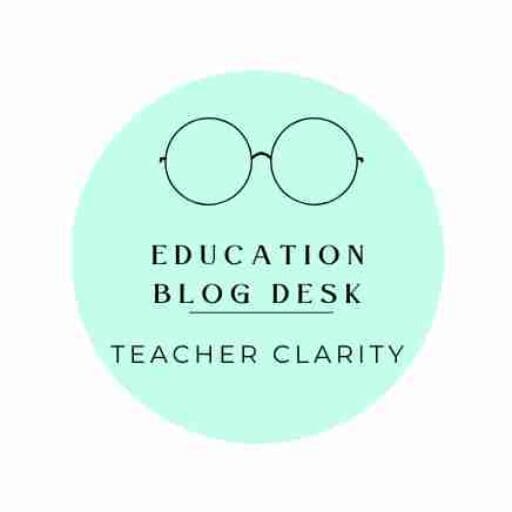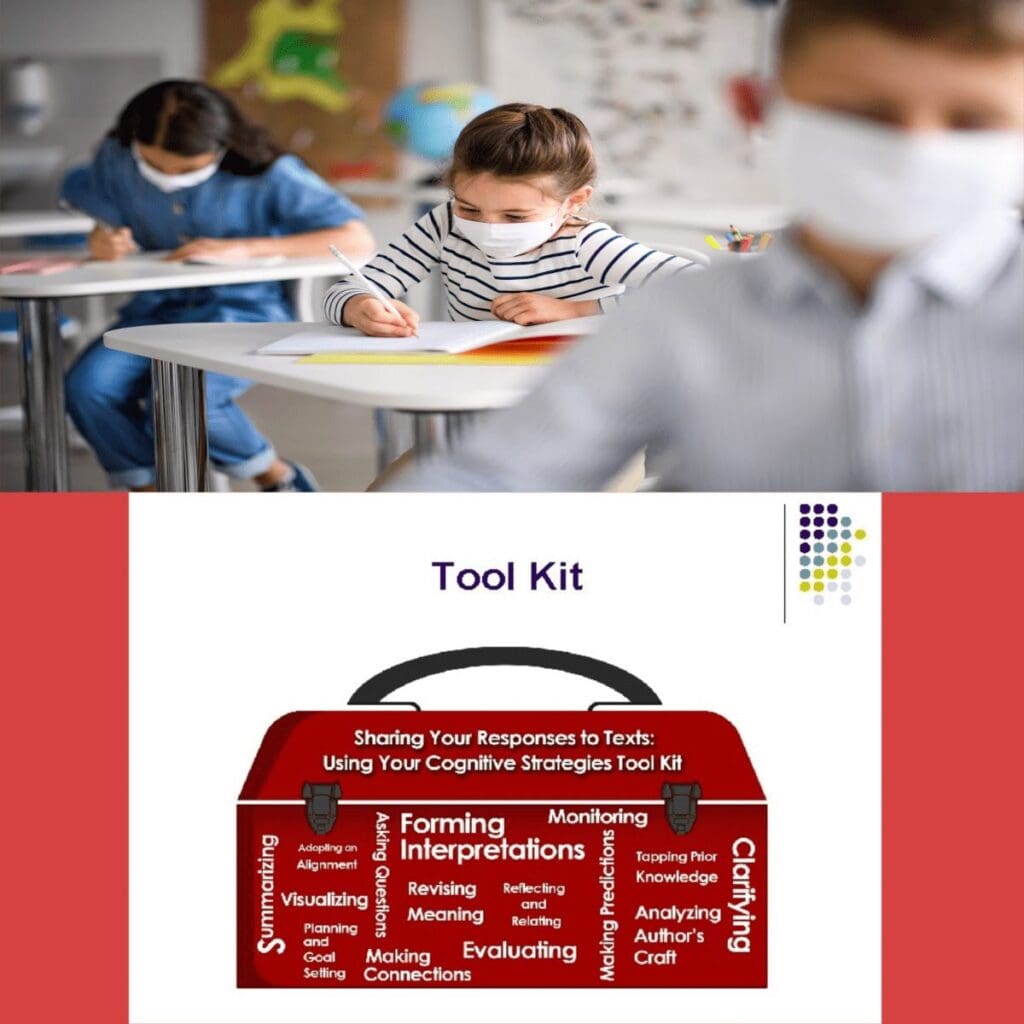
Thinking Tools Promote Higher Literacy
Thinking tools are cognitive strategies, including planning and goal-setting, tapping prior knowledge, making connections, forming interpretations, reflecting, and evaluating that experienced readers and writers used to construct meaning from and with texts according to Carol Booth Olson, author of Thinking Tools for Young Readers and Writers.
Based on research, Olson states “there is widespread agreement among literacy scholars that, along with decoding skills, students should be taught cognitive and meta-cognitive strategies in the early grades in order to become effective comprehenders and communicators.”
Olson presents 2 thinking tools and they are The Mystery Trash Challenge and The Cognitive Strategies Tool Kit. The two tool kits will help promote literacy among the young readers and writers.
The Mystery Trash Challenge
The Mystery Trash Challenge caught my eye to Olson’s book. This activity is a wonderful way to introduce the cognitive strategies to your students. Students examine several pieces of “trash” (evidence) to make inferences about the owners. It encourages students to use evidence to make inferences and support their thinking. Olson presents two different approaches to the Mystery Trash Challenge from two different classroom teachers.
Emily McCourtney’s classroom has 10 2nd- and 3rd-graders in a blended learning technology school. She puts a trash bag in the center of a large table, along with 10 magnifying glasses, one at each of the students’ seats. Emily told her students, “I have some new neighbors who moved in last week. I’m really curious about them, but they’re never home when I am so we haven’t met yet. But I guess they had so much trash that they put some in my can. So, guess what you get to do?” she asked. “You get to be detectives and help me figure out what my new neighbors are like. We need to make a plan before we start. What questions do we need answers to?”
Students asked questions including
“Do they have any kids?”
Emily: “Good question. How would their trash tell us if they had any kids?”
Student: “Diapers, or maybe some broken toys,”
Another student: “or maybe baby food jars, the food wrappers could also tell us if they like stuff like McDonald or if they’re healthier eaters.”
Jonathan: “What is this?”
River: “Metrolink card. So maybe they don’t have a car.” After students list their questions, they got to work examining the evidence. Using their iPads, they took pictures to document each item and began piecing the clues together.
Here are the items students documented:
- Metro link card
- Pink bracelet
- Target gift cards
- Candy bar wrappers
- Pamper boxes
- Magazines
- Receipts from Old Navy
Each student wrote up his or her conclusion via Google Slides in a digital notebook. Here is what Aimee wrote:
Your neighbors’ trash makes me think they went on expensive vacations because I found Hawaii Tickets. They have kids because they bought kid food. They went to an Angels game because they have Angels ticket. I think they’re healthy because they have organic food. I think they have a baby because I saw a box of diapers. I think they are 39, 40. I think they like tea because they had a box of tea.
At the end of the activity, Emily congratulated the class and said, “Hey, guys. You really did a great job looking at the evidence, piecing the clues together, and predicting what my new neighbors are like. I can’t wait to meet them and let you know if you were right. Tomorrow, we’re going to talk about all the thinking tools you used to create a picture of my new neighbors and how we can use those same tools to act like detectives to figure things out when we read and then to write up what we discovered.”
Figure 1.1
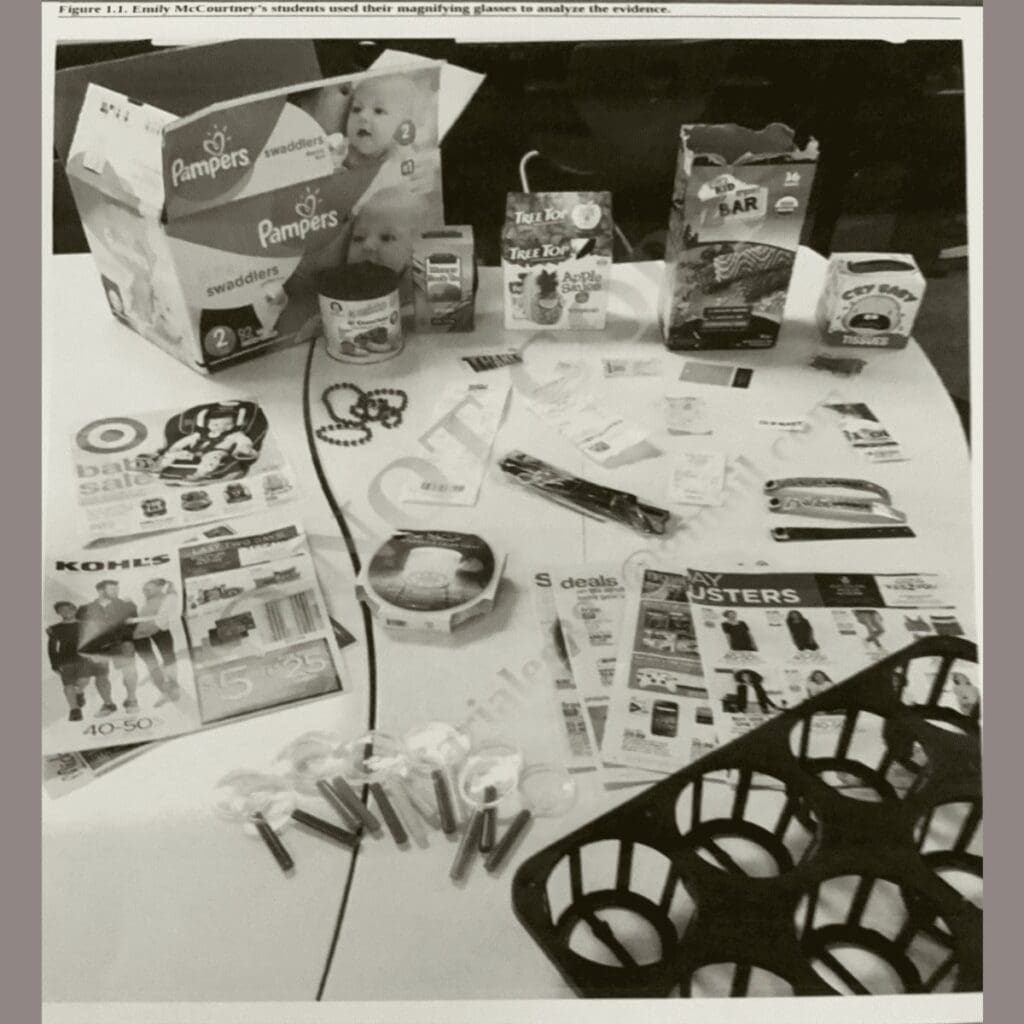
Another approach to Mystery Trash Challenge by Mary Widtmann, a 5th grade classroom teacher, has 27 students. Mary’s school is in a beach community with summer rentals. She needed a plausible excuse for collecting six boxes of trash.
Widtmann presents 6 mystery boxes, each containing between 15 and 20 items of trash. She told the students “she was helping a friend who managed a vacation rental apartment building clean out 6 different apartments whose families had moved out just before Labor Day”. Widmann customized the items in each box to depict different families and they are:
- A retired couple who likes art, museums, and traveling.
- A family that likes to go camping and eats junk food.
- A young family with kids who like amusement parks, etc.
The box for a healthy, sporty young family, for example, contained items like:
- A Nespresso package
- Dental floss
- A Quaker oats box
- A Planet Beauty receipt
- Mizuno
- Brooks running shoe boxes
- A Perrier water bottle
- One-Aday men’s vitamins
Widtmann model the process of analysis by demonstrating with trash collected from another teacher. She pulls each item out one by one and think aloud in front of the class. Widtmann reinforced the idea that you have to examine several pieces of evidence before making a prediction or drawing a conclusion. She also told students, “You might visualize one type of family and then some additional evidence might cause you to change your mind and form a new interpretation”.
Widtmann’s students working in groups to solve the Mystery Trash Challenge by creating a portrait of the family based on eight pieces of evidence from the box. These 5th grade students eagerly launched into the task. As they pursued the items, they created evidence tags just like a CSI investigation team.
Figure 1.2
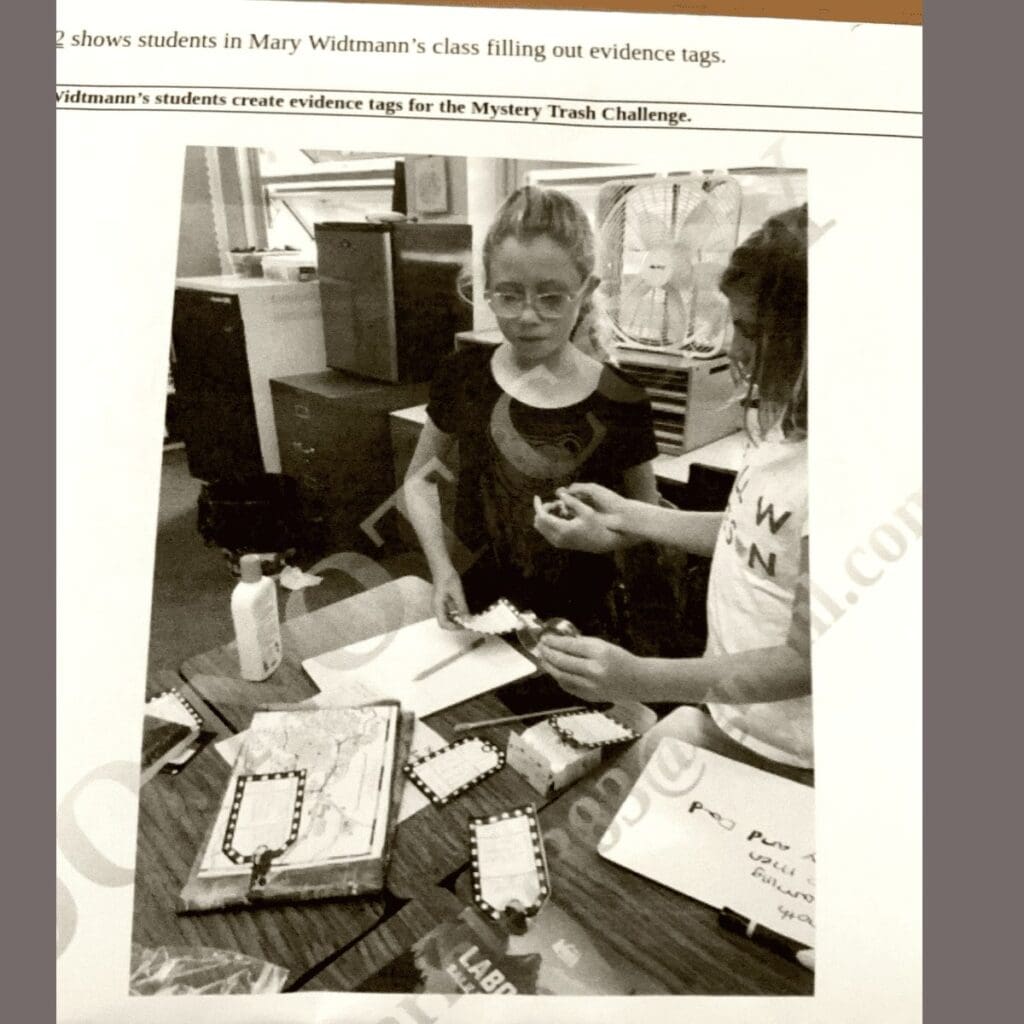
Emily and Mary engage their students in solving the “problem” of the Mystery Trash Challenge. Both were teaching the readers and writers of elementary students in their classroom to be strategic-asking students to deliberately and consciously employ thinking tools to get a goal.
Olson states what Paris, Wasik, and Turner (1991) point out, “Students who perceive themselves as academically successful ‘know how to learn effectively rather than just try harder’ because they have multiple tactics available to monitor and improve learning.” (pg. 625). Hence, experienced readers and writers are strategic.
Cognitive Strategies Tool Kit
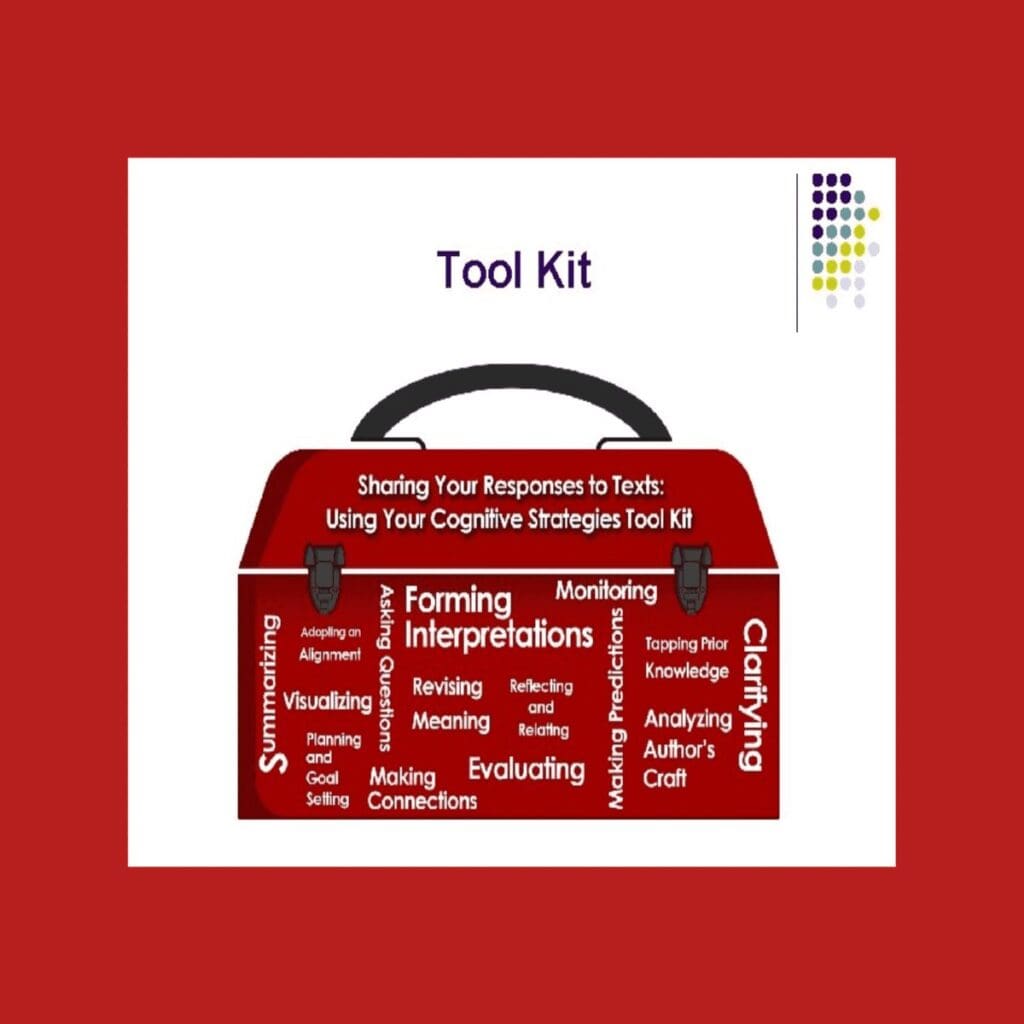
Olson emphasizes that it is crucial to introduce young readers and writers to thinking tools or cognitive strategies in their mental reader’s and writer’s tool kits. Cognitive strategies, including model strategy use, enable students to practice in collaboration with one another, and provide opportunities to select and implement strategies independently with various texts in a variety of contexts.
She provides a graphic representation of the reader’s and writer’s toolkit (Figure 1.6). We want to look at how we use these thinking tools to construct meaning both from and with texts. Olson outlines how we use it.
Planning and Goal Setting
Readers set goals and make plans for achieving those goals even before they start
Reading a text. For example, they might decide to read for pleasure, to learn how to do something, to develop better vocabulary, to prepare for a test, or to write an essay.
Readers formulate their plans regarding how to approach the text depending on their goals.
- What was your purpose or goal as you read this text?
- What plans did you make to achieve your goal or goals?
- How did planning and goal setting impact your reading of the text?
- Did planning and goal setting help you stay more focused as you read?
Cognitive Strategies Sentence Starters:
- My purpose is…
- My top priority is…
- I will accomplish my goal by…
Tapping Prior Knowledge
What kind of prior knowledge (i.e., background information), if any, did you bring to the reading of this text?
For example:
- Was there anything about the title that tapped information you already had?
- Did you have prior knowledge of the topic that helped you understand what you were reading?
- Did you know about the author or genre (i.e., poetry, short story, drama, essay, etc?) that influenced our reading?
- As you were reading, did you come across information that reminded you of something you already knew?
- Did having (or not having) prior information make this text easier (or harder) to understand and relate to?
Cognitive Strategies Sentence Starters:
- I already know that…
- This reminds me of…
- This relates to…
Asking Questions
What questions did you ask yourself as you read this text?
For example:
- Did you ask questions about what was happening in the text?
- Did you ask why (about events, characters, language the author used, etc.)?
- Did you find yourself wonder what would happen if…?
- Did asking questions motivate you to keep reading to find the answers or was it frustrating?
Cognitive Strategies Sentence Starters:
- I wonder why…
- What if…
- How come…
Making Predictions
What predictions did you make as you were reading?
For example:
- Did anything about the title of the text (or pictures, if there were any) cause you to make a prediction even before you started reading?
- As you were reading, did you find yourself predicting what was going to happen next?
- Did you think in terms of If…then (i.e., If x happens then I’ll bet that y will result.)
Did your predictions come true or did the text surprise you and turn a different direction?
Cognitive Strategies Sentence Starters:
- I’ll bet that…
- I think…
- If , then…
Visualizing
What pictures did you see in your head as you read this text?
For example:
What specific pictures stand out in your mind?
Did it feel like you were seeing photographs or watching a movie?
What was it about the author’s writing that helped you make mental pictures?
What affect did being able to make pictures in your head (or not being able to make pictures) have on you as a reader?
Cognitive Strategies Sentence Starters:
- I can picture…
- ? In my mind I see…
- ? If this were a movie …
Making Connections
As you read, what personal connections were you able to make between your experience and the text?
For example:
- Did the text call up personal memories for you (of experiences, events, people)?
- Did the text remind you of other books, stories, poems, movies, etc, you have read
or seen?
- Did the text make you think of actual events in the news or in history books that have occurred in the present or past?
To what extent did your ability to connect (or your inability to connect) with this text influence you as a reader? Were you more or less involved in it because of the connections you did or didn’t make?
Cognitive Strategies Sentence Starters:
- This reminds me of…
- I experienced this once when…
- I can relate to this because…
Summarizing
A summary is a brief statement of the main ideas, key points, or basic gist of a text. It
involves what is literally happening or being said, determining what details are
important, organizing information, and stating it coherently and concisely in one’s own
words.
- In your own words, what is literally happening in this text? What is the basic gist?
- In a nutshell, what does the text say?
- What essential information does the reader need to know about the characters, plot and setting in order to understand what is taking place?
- Was it easy or difficult for you to summarize this text? Why?
Cognitive Strategies Sentence Starters:
- The basic gist is…
- ? The key information is…
- In a nutshell, this says that…
Adopting an Alignment
To what extent were you able to get “into” this text?
For example:
- Did you feel you could get inside the setting of this text and be there? If so, what helped you to enter the text-world? If not, what made getting into the text difficult?
- Did you identify or feel a kinship with a particular character?
- Did something happen in the text in terms of events that really gripped you and drew you in?
- Did you feel you could relate to the author? If so, why? If not, why not?
How did being able to get into the text (or not being able to get into it) make you feel about what you were reading?
Cognitive Strategies Sentence Starters:
- The character I most identify with is…
- I really got into the story when…
- I can relate to this author because…
Monitoring
Did you ever think about yourself as a reader while you were reading and talk to yourself inside your head? If so, you were using a cognitive strategy called monitoring?
For example:
- Did you ever get confused and tell yourself you were not getting it and needed to go back and reread?
- Did you ever tell yourself you were on the right track and to keep reading?
- Did you come across any words you didn’t know and think about how to figure out the meaning or decide to keep reading and worry about it later?
Did thinking about your responses while you are reading and sending yourself messages to stop and backtrack or to full steam ahead help you to understand the text better?
Cognitive Strategies Sentence Starters:
- I got lost here because…
- I need to reread the part where…
- I know I’m on the right track…
Clarifying Understanding
As you were reading, you may have come across passages where your monitor told you are confused and you said to yourself “I don’t get this” or “I need to understand this better.”
- At what points in the text, did your monitor tell you needed to clarify your understanding?
- What did you do to make your understanding of the parts of the text that were confusing to you clearer?
- How did clarifying your understanding help you to engage in some of the other cognitive strategies like making predictions, visualizing, or forming interpretations?
Cognitive Strategies Sentence Starters
- To understand better, I need to know more about…
- Something that’s still not clear is…
- I’m guessing this means _______, but I need to…
Forming Interpretations
When we focus on what the text says, on what is literally happening or being said, we are reading. When we focus on what the text means, what its message is, we are interpreting. Interpretations are created by the reader in response to the writing of the writer. What is your interpretation of the meaning text you have just read?
For example:
- What is the message or BIG IDEA of all or part of this text, in your opinion?
- What in the text made you come up with the message or BIG IDEA that you did?
- Did your interpretation of the text stay the same as you read or did it change or grow as you continued to read? If it changed or grew, what happened that influenced your interpretation?
When you read something that has a deeper meaning and you figure out what it means to you and how does that make you feel as a reader?
Cognitive Strategies Sentence Starters:
- What this means to me is…
- I think this represents…
- The idea I’m getting is…
Revising Meaning
When we are reading a text, we often make predictions about what will happen next or we formulate interpretations about the message the text is conveying only to find our expectations thwarted when the text takes a surprising turn. This causes us to revise meaning and, just like a writer who creates a second draft of a text on the page, to create a new draft of the text that is unfolding in our imagination.
- Did your sense of the text stay the same as you read or did your interpretation change?
- What happened in the text that caused you to revise meaning?
- What new ideas did you get about what you were reading after you had to stop and revise meaning?
What impact did the act of revising meaning have on your enjoyment of the text? Did the challenge of revising your understanding make reading more or less enjoyable for you?
Cognitive Strategies Sentence Starters:
- At first thought ________, but now I…
- My latest thought about this is…
- I’m getting a different picture here because…
Analyzing Author’s Craft
What do you notice about the way the author uses language to get his or her ideas across?
For example:
- Is there anything about the author’s style or craft (i.e., the use of descriptive language, figures of speech like similes or metaphors, action words, dialogue, or particular types of sentences) that you found particularly effective?
- ? What golden words, lines and phrases stand out that made the writing vivid for you?
- How did the author’s style help you (or hinder you) as you made meaning from this text?
Is there anything the author of this text did that you would like to try in your own writing?
Cognitive Strategies Sentence Starters:
- A golden line for me is…
- This word/phrase stands out for me because…
- I like how the author uses to show…
Reflecting and Relating
What does this text mean to you personally? As you step back and reflect, what lessons, if any, can you take away from this text for your own life?
For example:
- Is there anything about the impact of this text upon you as a reader that has caused you to rethink what you already know about this author, genre, topic or arrive at any insights about your own life that you will take away with you? If so what new perspectives do you have?
- Is there anything you think differently about as a result of reading this text?
- Is there anything you will do differently as a result of reading this text?
What was it about this text that enabled you to relate it to your own life, if you were able to?
Cognitive Strategies Sentence Starters:
- So, the big idea is…
- A conclusion I’m drawing is…
- This applies to my life because…
Evaluating
Reflect upon the process of your meaning making as a reader and evaluate the quality of your experience. To what degree was the experience rewarding (or unrewarding) for you? Why?
For example:
- On a scale of 5 (It was great!) to 1 (It was awful!), how would you rate this text?
- What did you like best or least about this text?
- What did the author do (or not do) that caused you to respond to the text as you did?
- Will you read another text by this author or on this topic? If so, why? If not, why not?
Now, talk about the quality of your discussion as you went through this booklet with a partner or in your small group. What went well? What might you do differently to improve your discussion next time?
Cognitive Strategies Sentence Starters:
- I like/don’t like because…
- My opinion is because…
- The most important message is because…
Cognitive Strategies Reading Responses
https://docs.google.com/presentation/d/1odlkWwDhfVPeKAozIS2oW9SpwW2Ry89Gkhi5urNhV6Y/edit?usp=sharing
Big Al Student Packet
https://docs.google.com/document/d/1krao4yX16UMGwJ0ZNt12YpGuBdT12NetTTJb3IOBcFg/edit?usp=sharing
Using the Tool Kit in the Classroom
Angie Balius, a second-grade teacher, opened the Sears and Roebuck toolbox and began taking out the tools in her 2nd grade classroom. She asked students “Suppose you guys wanted to build a skateboard ramp, which of these tools would you need to use?”
“A hammer and nails,” said Michaela
“And a saw if the boards too long.” Blake added
Angie asked, “What about this?” holding up a wrench.
Jackson remarked confidently, “Now, you don’t really need a wrench because there’s nothing to tighten.”
Angie: “ok, I love that. Thank you for sharing.”
She explained to students “I want you guys to think about the tools we use to read and write today because in the same way that we use real tools to construct things like skateboard ramps, we also use the thinking tools in our minds to construct something when we read and write. What we’re constructing is meaning from words. Does that make sense?” 24 students nodded their heads.
Angie reminded students of a book they read “The Three Little Wolves and the Big Bad Pig.” She asked students “Did it go like we expected?” Students nodded their heads from side to side. “So, what did we have to do?” Angie asked. “We had to think about the Three Little Pigs and how the story was kind of like it but a bunch o things happened that we didn’t expect.”
“So, we built our understanding based on tapping our prior knowledge, but then when the story went a different direction, we had to revise our meaning. What other tools did we use?” Angie asked students.
Haley: “We made predictions, like when I predicted that the big piggy would use a jackhammer to knock the wolves’ house down, because concrete is hard to knock down.”
Angie: “And what made you think of a jackhammer?”
Haley: “My dad used one to remodel our house.”
Angie: “Oh great, so you made a connection.”
Angie wrote on the board each cognitive strategy with a black marker into a tool kit shaped poster on display, “Look! Our tool kit is filling up.” She exclaimed. “Let’s keep going.”
In Emily’s 2nd – and 3rd-grade classroom, she created her own readers’ and writers’ toolkit filled with objects to symbolize the cognitive strategies: puzzle pieces for making connections, a slinky for summarizing, a crystal ball for making predictions, so on and so forth. I am sure you are familiar with using objects to symbolize the cognitive strategies in your teaching.
Emily flipped her lesson by creating videos for her students to watch at home to introduce each of the cognitive strategies. When students returned to her classroom, she gave them a quiz on the learning-game platform Kahoot! to review and assess their understanding of the cognitive strategies.
Emily also developed icons that resemble apps and also use abbreviations to enable their cognitive strategies. To do this, she recorded her students’ conversations as they examined the evidence. Later she asked them to go back and label their cognitive strategy use.
I thought I highlight some interesting ways teachers can apply cognitive strategies toolkit in their classrooms.
Finally, I hope you find thinking tools to be useful in your teaching.
Here is an article on Metacognitive Strategies or Thinking about My Thinking for your reference.
You might want to check out 6 ways of making Thinking Visible https://educationblogdesk.com/6-ways-to-make-thinking-visible-a-powerful-practice/powerful-learning/how-meas-scs/
if you like thinking about thinking.
